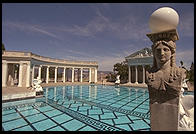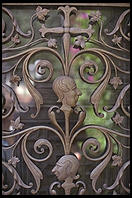

|
Acknowledgmentsby Philip Greenspun, part of Philip and Alex's Guide to Web Publishing |
 In Database Backed Web Sites, I declined to acknowledge
anyone in the front of the book. If someone had given me an idea, I
thought it was more honest to work their name into the main text. Also,
I couldn't resist reprinting my friend Olin's acknowledgments for the
Scheme Shell Reference Manual:
In Database Backed Web Sites, I declined to acknowledge
anyone in the front of the book. If someone had given me an idea, I
thought it was more honest to work their name into the main text. Also,
I couldn't resist reprinting my friend Olin's acknowledgments for the
Scheme Shell Reference Manual:
Who should I thank? My so-called "colleagues," who laugh at me behind my back, all the while becoming famous on my work? My worthless graduate students, whose computer skills appear to be limited to downloading bitmaps off of netnews? My parents, who are still waiting for me to quit "fooling around with computers," go to med school, and become a radiologist? My department chairman, a manager who gives one new insight into and sympathy for disgruntled postal workers?I was convinced that there would never be a more entertaining acknowledgments page for any technical book. Then I opened Who's Afraid of Java (Steve Heller 1997; Academic Press):My God, no one could blame me---no one!---if I went off the edge and just lost it completely one day. I couldn't get through the day as it is without the Prozac and Jack Daniels I keep on the shelf, behind my Tops-20 JSYS manuals. I start getting the shakes real bad around 10am, right before my advisor meetings. A 10 oz. Jack 'n Zac helps me get through the meetings without one of my students winding up with his severed head in a bowling-ball bag. They look at me funny; they think I twitch a lot. I'm not twitching. I'm controlling my impulse to snag my 9mm Sig-Sauer out from my day-pack and make a few strong points about the quality of undergraduate education in Amerika.
If I thought anyone cared, if I thought anyone would even be reading this, I'd probably make an effort to keep up appearances until the last possible moment. But no one does, and no one will. So I can pretty much say exactly what I think.
Oh yes, the acknowledgements. I think not. I did it. I did it all, by myself.
-- Olin Shivers, Cambridge, September 4, 1994
"Besides those who have directly helped me with this book, I'd like to acknowledge two of the greatest benefactors of mankind in general and myself in particular. The first of these is the greatest writer I know, Ayn Rand. She had the ability to explain complex philosophical concepts in language so simple that anyone could understand them; if I can explain programming half as clearly, I will consider myself a great success. Even more important, she laid the foundation for solving what is possibly the greatest conundrum of philosophy: how to connect what is with what ought to be.Seeing Olin so completely upstaged has given me hope that I too can write a memorable acknowledgments page. Here's my attempt..."Finally, I want to thank L. Ron Hubbard for his discoveries and inventions in the field of the mind and spirit. Even a small fraction of his myriad contributions to knowledge would qualify him for the first rank of friends of mankind; in total, they elevate him without question to the top of the list."
Bruce Lewis, my Corvette-driving eighth-grade English teacher, brought New Yorker articles to class, heaped scorn on inarticulate and complacent critics, and introduced me to the idea that writing matters. A whole generation of kids in Bethesda, Maryland is richer for his work (though since he was openly gay, I'll bet that, had he not died from a heart attack, he'd have a tough time getting a job in a modern school system).
Curt Roads, editor of MIT Press's Computer Music Journal, actually taught me how to write. He wore out red pens obliterating "obviously" and "in my opinion" from my text. He made me incorporate footnotes into the main flow. He kept the red ink flowing even as I quoted Gene Fowler to him: "An editor should have a pimp for a brother, so he'd have someone to look up to."
This book and the experience that underlies it wouldn't exist if not for my personal Web site. The Web site wouldn't exist if not for
"There are more than quite a few references to Philip... Not everyone wants to know this much about the author. The examples are sound but the self-citations are actually off-putting. This is an instructional text not a biography. There are ways of being personal without showing home movies."Ouch! The truth hurt but it was useful and made for a better final product. Apparently I didn't learn my lesson, though, because Edward Tufte independently came to the same conclusion after reading drafts of the first two chapters of this book: "the phrase 'self-indulgent' will occur to [readers]".
Let me say in my defense that the only sites that I can write about authoritatively and specifically are the ones that I've built. Those are the ones for which I have source code, for which I know how much and what kind of user confusion was generated, and for which I know the cost to build and operate.
Simon Hayes was the guy who originally convinced me to set down what I'd learned about Web publishing. Angela Allen, Jin Choi, and Paula Hardin told me what was wrong with the draft of my first book, of which 30 percent of the text has survived in this one. Mina Reimer did the napkin drawings that everyone loved. I've never met Bruce Lundquist or Janet Piercy, but Macmillan says that they did the (tasteful) interior design and page layout for that book. Joe Wikert was gracious about giving me back the rights so that I could take this book to Morgan-Kaufmann.
As for the M-K crew... Karyn Johnson made it painless for me to publish this book both on the Web and in print. Jennifer Mann, my editor, called me every day and shamed me into finishing the manuscript. Mike Morgan was willing to risk real money publishing the first coffee table Web nerd book; I'm not sure whether to thank him or try to have him committed.
Uber-designer Yonie Overton and Rad Proctor made the finished four-color work a reality. They treated my words and pictures with far more care than I would have myself. Yonie read the whole manuscript three times and rooted out more solecisms than any professional copy editor. For that alone, I want to have her baby.
The hardcopy book has been improved by hundreds of folks who read the on-line version and sent pages and pages of email corrections. This truly has been a collaboratively developed work.
For more on the gestation of this book, see http://www.photo.net/wtr/dead-trees/story.html.
Since 1976, it has been my privilege to be part of the MIT computer
science community, physically rooted at 545 Technology Square. Although
we've spent most of the past three decades trying to figure out how to
get the ventilation system to stop hissing (with nobody except Tom
Knight having any success), it is tough for most people to imagine a
building where a young nerd can walk out of his office on the fourth floor,
argue with the guy who started the free software movement (Richard
Stallman), annoy the authors of the best computer science book ever
written (Abelson and Sussman), walk up one floor to run a few ideas past
Dave Clark, Chief Protocol Architect for the Internet from 1981-1989,
and walk down two floors to talk to Tim Berners-Lee, developer of the
World Wide Web.